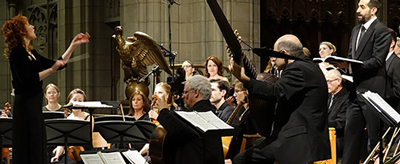by Daniel Hathaway

Taking as her point of departure a speculative performance of the work in Mantua in May of 1608 that marked the beginning of the wedding celebrations for Francesco Gonzaga and Margherita of Savoy, Jeannette Sorrell staged the Vespers with pomp and ceremony. Beginning with a drum cadence from the rear of the church, conductor and soloists processed down the center aisle and solemnly intoned Deus in adjutorium meum intende, followed by the festive response Monteverdi re-used from his gathering fanfare to Orfeo.
The next two hours featured a glittering parade of pieces: five inventive settings of Vespers psalms for double chorus with four interspersed “Motets” in the new theatrical style for soloists, then at the end, a spirited instrumental sonata with soprano obbligato, a rich elaboration of the hymn Ave maris stella, and a striking setting of the Magnificat.
The singers were constantly in motion, reshuffling their positions to suit each movement, and soloists or sub-groups moving to the front for special passages. Flanked by lute on one side and the giraffe-necked theorbo on the other, soloists for the four motets came forward into a virtual follow spot for their expressive show-stoppers. All had memorized these arresting pieces of vocal chamber music.
Tenor Oliver Mercer sang Nigra sum with ardent devotion. Sopranos Molly Quinn and Nell Snaidas faced each other, smiling, for their charming Pulchra es. Perfectly matched tenors Karim Sulayman, Mercer and Owen McIntosh chillingly invoked the awe of the divine presence in Duo Seraphim, and Sulayman and the chorus made an expressive, dramatic scene out of Audi Coelum, Mercer echoing the ends of lines from the back of the church.
Apollo’s Singers, 22 strong including soloists, sang with potent focus and laser-sharp intonation throughout the evening. Full-scored chords in Lauda Jerusalem, the fifth psalm, were absolutely stunning. Smaller, ever-changing combinations of voices in Ave maris stella — where alto Kristen Dubenion-Smith and baritone Jesse Blumberg took solo roles — provided welcome changes of texture.
But the two great showpieces of the evening came last. Sonata sopra Santa Maria gave the wind and string bands and continuo department a special opportunity to shine. Cornettists Bruce Dickey and Kiri Tollaksen vied with violinists Olivier Brault and Johanna Novom for virtuoso honors. Soprano Madeline Healey was first to brightly sing the chant melody against Monteverdi’s shifting metric patterns, later joined by two more, then all of her colleagues.
The Magnificat provided singers and instrumentalists with other ensemble combinations and clever effects to explore, including echo passages for cornetti and violins. Sulayman and Mercer, the vocal stars of the evening, got one more crack at dramatic declamations followed by echoes at the beginning of the Gloria.
Friday’s performance was impressive on all counts: brilliantly paced, arrestingly sung and magnificently played. It’s a lot of music to process in a single evening, but how often do you get to experience the complete Vespers? There are three local performances left before Apollo’s Fire takes the work on a seven-concert tour. Catch it on Saturday, November 1 at Trinity Cathedral, on Sunday, November 2 at St. Mary of the Falls in Olmsted Falls, or on Friday, November 7 at First Baptist in Shaker Heights.
Photo: Jeannette Sorrell conducts the Vespers at Trinity Cathedral (2014).
Published on ClevelandClassical.com November 1, 2014.
Click here for a printable copy of this article



